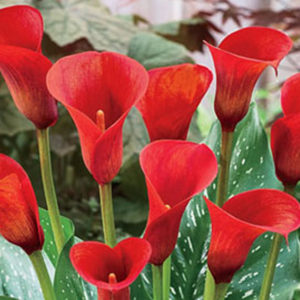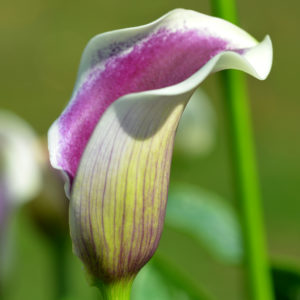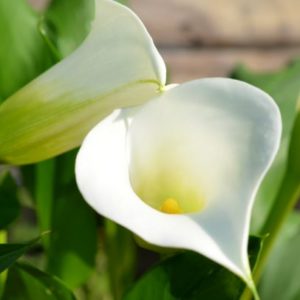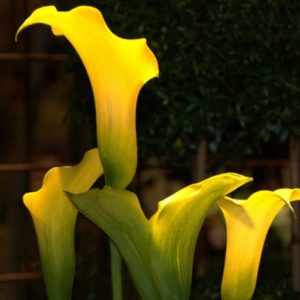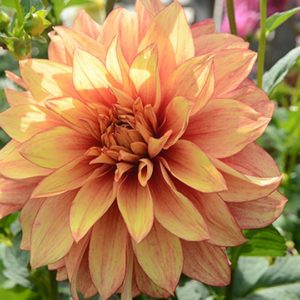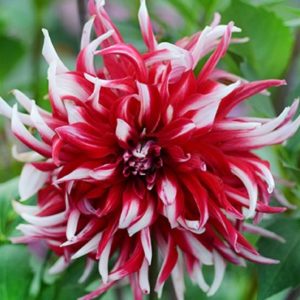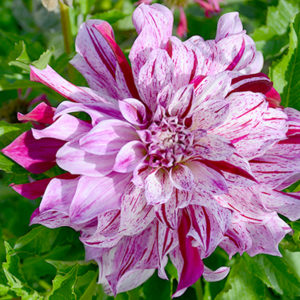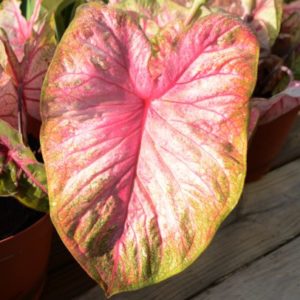Description
 Calla Lily, Orange Pitcher
Calla Lily, Orange Pitcher
Since before the Romans conquered the known world, Calla Lilies have been a revered flower, a flower of celebration and a universal symbol of purity. In Roman times, the Calla marked the passage of the Winter Solstice (December 21st) because it often bloomed around that time. In the doorways of their homes, the Romans planted Callas. The larger the Calla display – the wealthier you were. A blooming Calla symbolized “bringing the light indoors” on the darkest day of the year. Callas, in Roman times, were much larger and could reach a height of 7 feet. The wealthy would decorate the edge of the Calla bloom with gold leaf to enhance the beauty and create more brilliance.
Callas are not members of the Lily Family. They are Arums and as such are closely related to philodendrons, caladiums and, believe it or not, Skunk Cabbage. Thankfully they do not possess the stench that is associated with their cousins, the Skunk Cabbages. Callas were named after the Italian physician and botanist, Giovanni Zantedeschi (1773-1846). The aethiopica term means south of Egypt and Libya – a reference to the Calla’s native habitat in South Africa.
Calla Lilies are as close to the perfect plants as you are going to get on this planet. They can adapt to full sun or partial shade. For a tropical, callas are incredibly hardy and with careful mulching and a protected environment can withstand temperatures below freezing. They multiply rapidly. They LOVE being grown in containers and make excellent houseplants as well as outdoor plants. They are the easiest of all plants to winter over in your home, and both their leaves and their “flowers” are exotically ornamental.
The Calla ‘flower’ is really an ornamental leaf, similar to a flower petal and known as a ‘spathe’. This spathe surrounds a nondescript spike which is the true Calla flower. These brilliantly colored “blossoms” the plant uses to attract pollinators and to protect the nondescript flowers which emerge from the center of the spathe. The blossoms last for an incredibly long time – at least 4 to 6 weeks. They make excellent cut flowers. AND, because of their tolerance for low-light conditions, they CAN be grown indoors! It is nearly impossible to find a group of plants with so many desirable attributes.
All of the Calla Lily species are native, exclusively, to South Africa. This is somewhat rare for a plant family to be native to such a small area. Callas were introduced into Europe by the Romans, but because of their fragile tropical nature were not widely known. An early reference to the Calla from a French discussion of gardens in Paris occurred in 1664. The plants were re-discovered in the early 1700s and introduced for commercial sale in Europe and the British Isles in 1731. The plants exploded in popularity during the Victorian Era (1837-1901) when Upper and Middle Class Europeans, Brits and Americans began to engage in leisure travel and observed these plants in their native South African habitat. In their native habitat, Calla Lilies can grow to 6+ feet with spathes as large as 1 foot. The Calla became popular in the late 1800s with the advent of greenhouses and conservatories. The plant was grown for its beauty and botanical interest in such facilities.Outside of their native environment, Calla Lilies rarely grow taller than 36 inches, and most of the new cultivars have been bred to be less than 24 inches.
Orange Pitcher is a very rare deep orange to rust color which makes it a standout in the garden. There simply is no other flower with this color. The leaves have slight variegation. The plant reaches a height of approximately 10-14 inches.
At Harvesting History, we believe that Calla Lilies, like dahlias, are some of the most underappreciated plants available to Americans today.
Planting Calla Lilies in Your Garden
Calla Lilies are grown from a type of bulb known as a corm. Corms appear to be a somewhat flattened disk with a top and a bottom.
Corms, unlike true bulbs, only last for one year, but during that year they produce bulblets from small round protrusions located on the surface of the bulb as you can see from the following photo. These bulblets will each form a new plant. The original corms can be incredibly prolific.
Calla Lilies need 3 things:
- Lots of organic matter
- Frequent feeding
- Frequent watering
If you are planting Calla Lilies in the ground remember that Calla Lilies are not, in general, hardy except in Zones 7-11. The one exception is Calla Aethiopica which, if mulched and planted in a protected area, can be hardy in Zones 6-11.
When planting Calla Lilies in the ground, dig a hole about 8 inches deep. Amend the soil you will place back in the hole with peat moss. This will provide the bulb with great organic matter. Mix ½ soil and ½ peat moss. Place about 2 inches of soil mix in the hole and then dust the hole with bone meal (about ¼ cup). Place the bulb in the hole and fill the hole with your peat moss and soil mixture. Then soak the area with water.
If planting more than one Calla Lily and they usually look better when planted in groups of three, separate the corms by 4-6 inches.
Calla Lilies perform best when fed a high nitrogen fertilizer. Remember that what you are hoping to achieve is various kinds of leaf growth, so nitrogen is what is necessary. Mulching in the fall with compost is highly recommended. However, we have a better idea when it comes to planting Calla Lilies in the ground. We think you should plant all your Calla Lilies in pots and then bury the pots in the ground.
Planting Calla Lilies in Containers
Calla Lilies can be grown easily in containers. We recommend using a 6-7 inch diameter container and planting 1 bulb per pot. Check out the soil mix described in detail in our Harvesting History YouTube video. Do not use prepared soil mixes.
The Best Soil Mix for Containers
Harvesting History has a collection of YouTube videos on calla lilies. Click on the individual link to view each video.
CALLA LILIES – THEIR HISTORY AND BACKGROUND
PLANTING CALLA LILIES IN CONTAINERS
4 GREAT CALLA LILIES


